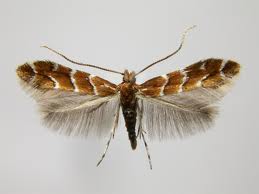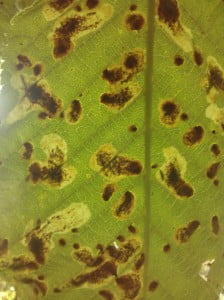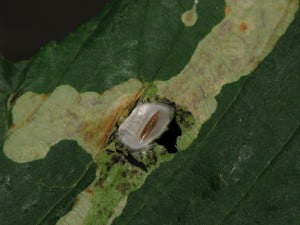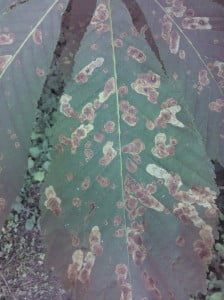These are horse chestnut leaves. As you can clearly see they have been invaded by something that is making them go brown. In fact, it is caused by the actions of the Horse-chestnut leaf miner moth larvae (Cameraria ohridella).
Each female moth lays between 20 and 40 eggs singly on the upper surface of leaves, and once these hatch 2–3 weeks later, the larvae develop through five feeding phases (or instars as they are called by entomologists) and two pre-pupal (spinning) phases before the pupal phase.
When the eggs hatch, the larvae will eat the chlorophyll in the leaf. After spending around two weeks as a caterpillar it will morph into a moth and the cycle will continue right up until October, so what damage does it do to the tree ? Fortunately, not as much as you might think! When the larva eats the chlorophyll, the leave cannot produce enough sugars through photosynthesis. As a result , by the end of September the tree has shed all its leaves and goes into winter shut down when all other trees are only just starting to show their autumnal colours.
Although a blight on our Chestnut trees the moth only feeds off of the white flowering variety and not the red flowering variety , they are an important food source for woodland birds and I have sat under a tree and watched many species all feeding on the moths and their larvae.
Interesting Facts:
The horse-chestnut Leaf miner moth was first noticed in Britain only as recently as 2001. It’s native country is Greece.
Life cycle
It can have several generations of young in one season known as an ephemeral life cycle so the tree has no chance of escaping them. On average the moth goes through three generations each year.
At its peak a single tree can host up to 100.000 larvae
Can it be controlled ? No is the simple answer , however a number of natural predators of the larval stages of C. ohridella have been recorded. Observations have shown that blue tits (Parus caeruleus), great tits (Parus major) and marsh tits (Parus palustris) feed on the larvae. Between them, three tit species are thought to predate between 2 and 4% of the larvae.
There is also a parasitic wasp that will search out the larvae in the leaves and inject its own egg into the larva ,the wasp larva will develop faster than the moth’s and will eat it. In urban areas the only means of reducing the spread of the moths is to collect all the fallen leaves in the autunm and burn them.



